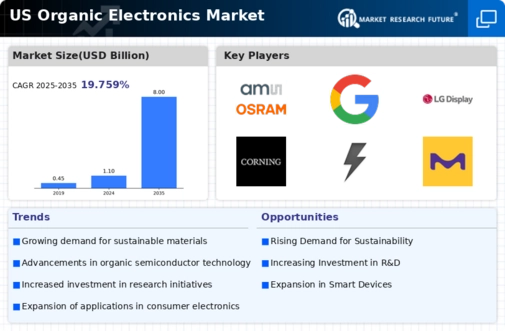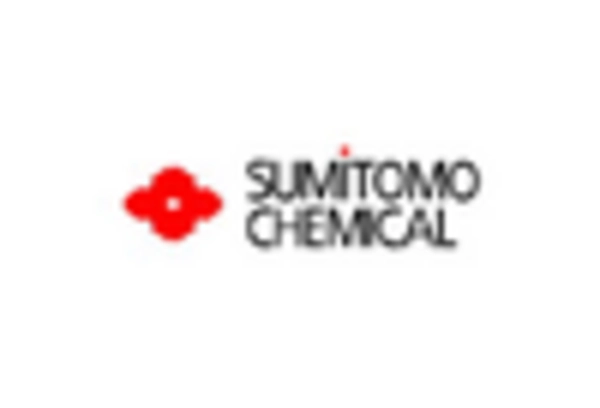Consumer Electronics Market Growth
The organic electronics market is closely linked to the expansion of the consumer electronics sector. As the demand for high-quality displays and energy-efficient devices continues to rise, organic electronics are becoming increasingly relevant. In 2025, the consumer electronics market in the US is anticipated to exceed $400 billion, with a significant portion attributed to organic display technologies such as OLEDs. These displays offer superior color accuracy, contrast, and energy efficiency compared to traditional technologies. Consequently, manufacturers are likely to integrate organic materials into their products to meet consumer expectations for performance and sustainability. This trend is expected to bolster the organic electronics market, as companies strive to innovate and differentiate their offerings in a competitive landscape.
Government Initiatives and Funding
Government initiatives aimed at promoting advanced manufacturing and technology development are playing a crucial role in the organic electronics market. In the US, federal and state programs are increasingly providing funding and support for research in organic materials and their applications. For instance, the Department of Energy has allocated substantial resources to projects focusing on organic photovoltaics and organic light-emitting diodes (OLEDs). Such investments not only stimulate innovation but also encourage collaboration between academia and industry. The financial backing from government entities is likely to accelerate the commercialization of organic electronics, making them more accessible to various sectors. This supportive environment is expected to enhance the competitiveness of the organic electronics market, driving growth and technological advancements.
Advancements in Organic Photovoltaics
The organic electronics market is witnessing advancements in organic photovoltaics (OPVs), which are becoming increasingly viable for energy generation. These technologies offer the potential for lightweight, flexible solar panels that can be integrated into various surfaces, including buildings and vehicles. The US market for OPVs is projected to grow significantly, driven by the need for sustainable energy solutions. As efficiency rates improve and production costs decrease, OPVs are likely to gain traction among consumers and businesses alike. This shift towards renewable energy sources aligns with broader environmental goals, further propelling the organic electronics market. The ongoing research and development in this area suggest a promising future for organic photovoltaics, potentially transforming the energy landscape.
Rising Demand for Flexible Electronics
The organic electronics market is experiencing a notable surge in demand for flexible electronic devices. This trend is driven by the increasing adoption of wearable technology and portable devices, which require lightweight and bendable components. In 2025, the market for flexible electronics is projected to reach approximately $20 billion in the US, indicating a robust growth trajectory. The ability of organic materials to be printed on various substrates enhances their appeal, allowing for innovative designs and applications. As consumer preferences shift towards more versatile and adaptable products, manufacturers are likely to invest heavily in research and development to meet these demands. This growing interest in flexible electronics is expected to significantly influence the organic electronics market, fostering advancements in product offerings and expanding market reach.
Integration of Internet of Things (IoT)
The integration of the Internet of Things (IoT) is emerging as a pivotal driver for the organic electronics market. As smart devices proliferate, the demand for lightweight, energy-efficient components is escalating. Organic electronics, with their inherent flexibility and low power consumption, are well-suited for IoT applications. In 2025, the IoT market in the US is expected to surpass $1 trillion, creating substantial opportunities for organic electronics manufacturers. The ability to seamlessly integrate organic materials into smart devices enhances their functionality and user experience. This trend indicates a growing synergy between organic electronics and IoT technologies, which could lead to innovative applications and solutions. As the market evolves, the organic electronics sector is likely to play a crucial role in shaping the future of connected devices.
















Leave a Comment